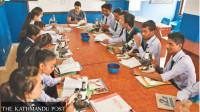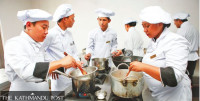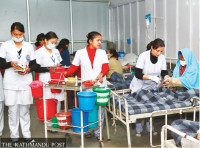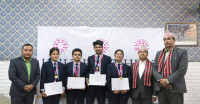Miscellaneous
Lassoed in
The first time we’d met Gal Gadot’s Wonder Woman in her relatively compact appearance in last year’s Batman v Superman:
Obie Shrestha
The first time we’d met Gal Gadot’s Wonder Woman in her relatively compact appearance in last year’s Batman v Superman: Dawn of Justice, I’ll admit to having been fairly dismissive of both the actress and her character—more so when I learned she was to soon star in a solo feature. Part of it had to do with DC’s dismal track record in the past few years—in 2016 alone, for instance, we got two of the most overhyped superduds in recent blockbuster memory in the form of the aforementioned BvS and Suicide Squad, and these were just the latest in a string of disappointments, a decline that pretty much corresponded with the closing of Christopher Nolan’s Dark Knight trilogy in 2008. Needless to say, it seemed safer to reign in our expectations when it came to DC fare.
Another factor was that I’d never really been too fond of the Wonder Woman onscreen canon itself—namely, the TV series from the 70s starring Lynda Carter—and did not believe that a modern reimagining could fully divest the character of its campy, and yes, “overtly sexualised” (to borrow a phrase from the UN’s explanation of why it was dropping WW from a shortlived stint as the organisation’s honorary ambassador) roots. Sure, there were some grounds for hope in the fact that the film was being directed by Patty Jenkins, who had racked up the accolades for 2003’s Monster, but even so—given the sky-high commercial stakes surrounding the mass migration of comic-book heroes to screens big and small at present, and the constraints placed on creativity by the now-ubiquitous compulsion to create not just a stand-alone film, but rather pieces to be slipped into designated slots within a broader “universe”—it’s a task that’s trumped many a good director and one I wasn’t entirely sure Ms Jenkins would be up to.

But I was wrong. Wonderfully, gloriously wrong. Because the new live-action Wonder Woman is exactly the sort of thing one hopes to see when going into a superhero film. Thoughtfully made, well-performed, with some pretty nifty visuals, and funny too—not the trendy, ‘ironic’ variety of humour either, but the kind of warm, heartfelt stuff that movies like BvS could’ve used multiple doses of. It does eventually lean on formula, and includes several overlong, nonsensical portions, but more often than not, WW hits the right notes, easily grabbing a spot among the best recent endeavours in the genre.
It’s 1918, and we’re on the all-female island of Themyscira—location: undisclosed and home to a powerful race of Amazonian warriors led by Queen Hippolyta (Connie Nielsen). Hippolyta has a daughter, Diana (Gadot), conceived with the king of gods himself, Zeus, and the Queen has made it her life’s mission to protect the child from Ares, the god of war, who has something of a bone to pick with Zeus. Diana would very likely have grown up being treated like a glass doll if not for the intervention of her aunt Antiope (Robin Wright) who convinces Hippolyta that the girl must learn to defend herself, and trains her to become one of the fiercest fighters in their ranks.
Meanwhile, beyond the invisible borders of this idyll, World War I is still in full swing in many countries. But it’s only when American intelligence officer Steve Trevor (Chris Pine), on the run from the Germans, crash lands nearby one day and Diana drags him out of the water that she learns—once she gets over the shock of seeing a man for the first time in her life, that is—of the horrors of the war, the millions dead and dying. Convinced that this is the work of Ares, known for poisoning men—otherwise inherently good and pure, she’s been told—against one another, Diana decides to head out to the frontlines of battle, accompanied by Steve, to seek out Ares, kill him and end the war. Disillusionment awaits her, though: she is about to find out that she may have grossly overestimated mankind’s capacity for goodness, and that the realities “out there” are far more complicated than the fairytales of her childhood might have let on.
WW can’t entirely skirt the usual pitfalls of the Origin Story—clunky expositional dialogue for one, and the sort of prolonged, CGI-pounding final act that we see in far too many of these films far too often. But Jenkins and screenwriter Allan Heinberg manage to focus sufficiently on the more intimate, human moments early on—whether it’s to do with Diana’s dynamics with the other Amazons, the easy, frisky banter she strikes up almost instantly with Steve, or the hilarious, but also quietly informative, fish-out-of-water sequences that show our heroine stepping into the human world with its bizarre restrictions on women. So that when the action floodgates are finally opened, we have enough affection for these characters to genuinely want them to pull through. In any case, there’s a rare clarity to most of the fight scenes here; those that prop up early on have been choreographed especially well, practically dance performances given all the grace and artistry they embody.
Jenkins has also managed the particularly tricky feat of allowing Wonder Woman to retain her iconic metal bustier and tiny skirt, without making the ensemble feel tarty or at all provocative. This has to do, foremost, with the kind of gaze that’s adopted by the film and its other characters towards our young demigod—reverential rather than lascivious, a respectful awe in place of common lust, there is no uncomfortable ogling of flesh, no cheap jokes bandied about. And backing it up is Gadot’s incredibly athletic physique—all taut lines and bronzed muscle, strength and steely resolve—that practically transcends objectification; sexy, most certainly, but a bold, powerful, self-assured kind of quality instead of something geared at easy titillation. It’s these subtle ways in which WW serves up its subversions that make them so effective: it doesn’t noisily announce its intentions to bust gender stereotypes, but simply goes ahead and does it, as if to say, Shouldn’t it be obvious already? Do we really need to debate the absurdity of it all?
And Gadot turns out to be the perfect vehicle to carry that attitude: the Israeli actress might not be the most nuanced of performers per se, but she’s just right for a project like this, with a warmth and earnestness that makes her very easy to root for, the acrobatic chops of a bonafide action star, and a sort of quiet gravitas about her that lends credibility to her hero status. And Pine provides great company—their chemistry off the wall right from the get go, not a false note in there—the repartee between them making for some of the movie’s most enjoyable bits. The second-tier actors are a mixed bag, however: those playing the Amazonians are good, but I wish their accents had been toned down to sound less cartoonish; the villains are rather one-note baddies; and the comic-relief team inserted belatedly a touch too forced in its efforts.
There are a lot of firsts here: this is the first major superhero film to be directed by a woman, the first female-directed film with a budget of over $100 million, and the first female-led superhero film in over a decade (the last being 2005’s utterly forgettable Elektra), among other accomplishments. And though it’s going to take many more iterations of such success to bring balance to a genre that has so far remained persistently male-dominated, it’s a great place to start, at least. I’m with Diana.




 21°C Kathmandu
21°C Kathmandu











